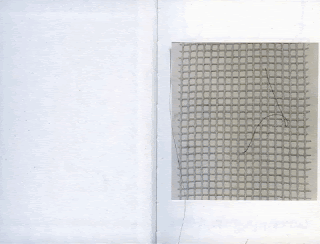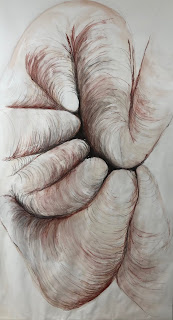Guest drawing blogger: Megan Needham
Megan Needham is today’s guest blogger. Megan was a Fine Art student at Leeds College of Art from 2012 to 2015, her practice at the time being concerned with repetition, seriality and order found within everyday objects. The visual qualities of these ubiquitous structures would become the starting point for heavily repetitive and time-intensive drawings which often centred around the formation of a grid.
Since leaving, she has exhibited in various group shows across Leeds, Manchester and York. In 2016 she completed a PGCE in secondary Art & Design at Manchester Metropolitan University and continues to teach. In 2018 she was awarded a sketchbook prize at Manchester School of Art and more recently won the People’s Choice Award in MADE IT --Short Supply’s (an artist-led initiative and curatorial collective operating in Salford) graduate show. She has recently completed her MA in 2019 at Manchester School of Art.
She is currently working at Rishworth School and continues to develop her art practice, a practice that has become much more sculptural and organic. Recent work has seen her responding to a series of forms that mutate and evolve as if they were embryos, each ‘mutation’ having anthropomorphic qualities reminiscent of the human body.
Megan’s blog post describes what drawing means for her and it explains how her approach to drawing has changed as her practice has evolved.
Drawing mutations: Megan Needham
I was always encouraged to keep a sketchbook whilst a student at Leeds College of Art. Working in a sketchbook format became an important part of how I developed my practice and it was a way of collecting my thoughts together. It became habitual and comfortable to work at an A6 sketchbook size and consequently lots of my work produced around this time was of a small scale. It taught me how valuable drawing was and how drawing could operate as an overlap between disciplines, as I started to consider more three dimensional possibilities, such as objects with linear qualities existing in space or coming out of the paper.
Various Sketchbooks 2012-2015
Typical sketchbook pages from my time at LCA
Examples of LCA student work
Whilst studying for an MA at Manchester School of Art I was encouraged to leave the safe confines of the sketchbook and I started to realise some of the forms I had been obsessively drawing, as sculpture. As my sculptural work was developing, I found myself returning to a sketchbook to plan, to think, to visualise and record my ideas of how to resolve the sculpture in progress or develop ideas for new works. As I progressed some of these works on paper stayed as drawings and others became information from which I was to develop sculptural forms. For me there is a symbiotic relationship between drawing and sculpture; each informs and generates momentum from the other.
Contained Form. Mixed Media on Fabriano 100x200cm approx. (in progress)
Contained Form. Pencil Crayon on paper 7x15cm
Slob (right) 2019. Paper mache, tissue, paint, wood. 120x70x90cm
Baby (Left) 2019. Paper mache, tissue, paint. 35x30x22cm
Untitled. Paper mache, tissue, paint, wood (in progress) 90x50x120cm
Untitled. Paper mache, tissue, paint, Sellotape, varnish, wood (in progress)
Pupa. 2019. Paper mache, tissue, paint, Sellotape, varnish, wood. 20x32x130cm
Chewing Gum Study. 2019. Gum, Fabriano paper. 15x15cm
As I was thinking about how and what materials to use when making sculptures, the thought processes also emerged in my works on paper. In particular I began using chewing gum as a way to ‘sculpt’ forms and shapes within the space of the paper. For the materials I am now working with I look for softer qualities that can easily be manipulated.
Contained Forms is a series of works on paper where the resulting outcomes are abnormal, organic, mutated forms that are repetitive, obsessive and that continue to evolve throughout the series of work. They have anthropomorphic qualities, are reminiscent of embryonic limbs, folds of flesh, wrinkles of skin and curls of hair. I am interested in allowing the forms to develop intuitively but I also want them to share a quality of being restricted and contained within the confines and edges of the paper.
Contained Forms. 2019. Hardground Etchings on Steel. Printed on Fabriano Rosapina. 15x30cm
These works range in size, which changes the way I physically make the work. On a smaller
scale, marks are made using the flick of my wrist and are limited to the range at which it can flex back and forth. When working on a larger scale the drawing becomes much more rhythmical and relies on the whole movement from my shoulder and the range of movement from my elbow. The forms in these larger drawings are of a similar size to my sculptures and are also related to human proportions, creating an uneasy relationship with the viewer that can at times be almost confrontational.
Henry Moore: Shelter Drawing: Underground Study: 1940
Gouache, brush and grey wash, coloured wax crayons, pen and black ink over pencil on paper. 12.3 x 17.7 cm.
To reveal mass and the three dimensional nature of form, I make use of a network of fine, curved, cross contour lines. This was a style adopted by Henry Moore who used these types of marks in combination with wax crayon, ink and wash to produce his series of Blitz drawings. Mixing and layering materials is something I do both when making drawings and sculpture, to create tactile and visceral surfaces. It is also a tool sculptors use to indicate weight as well as form in a preliminary sketch
.
During this period of social distancing, I have downsized my studio quite significantly to the space of a desk. This is changing the nature of my work but I am working with what I have to hand and embracing new ideas. I have started a sketchbook; a continuation of the contained forms series, exploring drawing and being experimental with combinations of materials and approaches to mark making. I’ll be sharing on my Instagram how these drawings develop: @megan__needham
Recently, with so much advice on how to wash your hands properly to reduce the spread of coronavirus, I have been thinking about how the virus is passed on from person to person by physical contact. This is a very sculptural concept, touch being central to our idea of form. When something is touched traces are left behind from the natural oils in your fingertips. You can see the layer upon layer of greasy prints if your phone is left on lock and you hold it up to the light. These invisible latent fingerprints are made of water, fatty acids, amino acids and triglycerides—in other words, they result from the oil and sweat that your skin produces naturally. The reoccurring messages from PHE about handwashing make you more aware of how many surfaces each day we touch. I have been thinking of mapping these traces as drawings.
These images of traces reminded me of some of the work made by the artist Jack Brown, who would collect the grease marks left by passengers’ hair rubbing against the glass windows on public transport.
Jack Brown: Traces from a bus window
Some traces are invisible and others are much easier to see, whether or not the trace is something left at a microscopic level or is something that exists in our macro universe, it will be the result of things coming together and as they do a change is made. The police when recording a crime scene are very aware of Locard's exchange principle, "Every contact leaves a trace". As an artist when you begin to research these traces, you could be thought of as a type of crime scene investigator, something that feels very appropriate when thinking about how the corona virus spreads.
Earlier this month I took this photo of the back of a lorry which interested me because of the mark making qualities and how the stained cloth resembles a prepared ground on which you might make a drawing. This is a found drawing, like Jack Brown’s work, it can be thought of as a residue of an event or series of events involving someone and something. Which is giving me some food for thought…
Scientific imagery of the internal human body has in the past acted as a reference and starting point for new drawings. The formations in my earlier etchings were inspired by the microscopic structures within our bodies. For example in our digestive system we have villi on the surface of the colon; small finger like projections that increase the surface area to uptake nutrients from digested food. Although invisible to us, they are an essential aspect of our lives and without them we could not function. The forms that villi take were seen by myself as electron microscope photographs and as images made by specialist scientific and medical illustrators. My own drawings then extended these ideas, trying to lend mass and weight to them, in order to give the concept of their invisibility and yet purposefulness, a certain gravity as well as mystique.
Contained Form 2019. Hardground Etching on Steel. Printed on Fabriano Rosapina. 15x30cm
The corona virus
During this last month, many images were being shared in news articles of the visual structure of the coronavirus. These images have shown how the spiked projections on the surface of the virus binds on to the host cell and infects it. They adhere to various surfaces because of their pairing with the receptor site and can be loosened by the application of soap. The images of the virus differ between a 2D or 3D image depending on what sort of microscope has been used. From these microscope derived photographs, 3D illustrations have been digitally rendered, each one designed to pick out certain ideas about the virus. These illustrations will have been produced in response to a dialogue between scientists and illustrators. I have been looking a lot at these kinds of images and drawing from them to generate new work, whilst I do this I am thinking about how I might take a flat image into a sculptural form. This has been something I have struggled with recently – because the drawings have been produced from my imagination as well as from 2D imagery derived from secondary sources, and not from direct observation. This means that when trying to realise them as objects they don’t quite work in the same way I envisaged them in my mind.
It is always interesting to have a dilemma to solve. Do I make models to work from? Do I insert x, y and z axis into and through existing drawings so that I can rotate them in my mind and on paper? Do I make drawings that I then cut up and reassemble? Do I gradually extend my drawings by adding more and more 3D materials to them? Do I create drawings on the surface of 3D forms and then re-draw them? Do I develop a process of working with materials that reflects the way a virus is transmitted or how it is broken down by lipids?
See also:
These are a few posts that touch upon some of the issues raised.




























Informative blog.
ReplyDeleteHoney in Pakistan
Parkview City Payment Plan
seo services in lahore
Termite Treatment in lahore
hearing aids in lahore
speech therapy in faisalabad
fire alarm system in lahore
termite treatment in Lahore
Chemical Industries in Lahore
mens suits
travel agency in lahore
hearing aid Pakistan